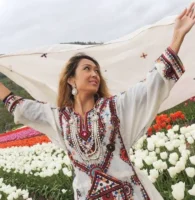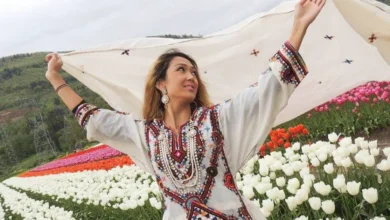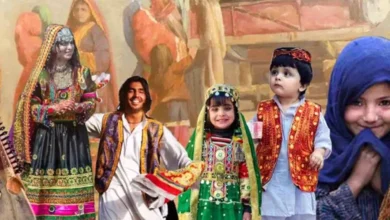Discover the deep cultural roots of Sindhi Ajrak and Topi — iconic symbols of identity, resistance, and artistry from Sindh, Pakistan. Explore their history, making, meanings, and modern revival.
More Than Fabric and Thread — A Language of Identity
In the sunbaked plains of Sindh, where the Indus River whispers ancient tales, two humble objects speak louder than words:
→ The Ajrak — a block-printed shawl of indigo, crimson, and white
→ The Sindhi Topi — a velvet cap embroidered with mirrors and silk
Together, they are not just attire.
See also Phulkari Embroidery of Punjab: The Art Behind Traditional Dresses
Phulkari Embroidery of Punjab: The Art Behind Traditional DressesThey are emblems of pride.
They are echoes of resistance.
They are woven archives of a 5,000-year-old civilization.
Worn by poets and farmers, activists and brides, the Ajrak and Topi are the heartbeat of Sindhi identity — silent, steadfast, and stunningly beautiful.
Let’s unravel their story.
🧵 What Is Ajrak? The Soul of Sindhi Textiles
🎨 A Masterpiece of Block Printing
Ajrak (sometimes spelled “Ajrakh”) is a hand-block printed textile, traditionally made from cotton or silk, using natural dyes and intricate geometric or floral patterns.
See also Balochi Embroidery and Tribal Dresses: Patterns of Nomadic Tradition
Balochi Embroidery and Tribal Dresses: Patterns of Nomadic TraditionIts name may derive from the Arabic word azrak (أزرق), meaning “blue” — the dominant color in most designs.
🔵 Signature Colors & Their Meanings
| Indigo Blue | Indigofera plant | The universe, depth, wisdom |
| Madder Red | Madder root | Life, passion, sacrifice |
| Cream/White | Camel dung + milk (traditional mordant) | Purity, peace, the Indus River |
| Black | Iron scrap + jaggery | Protection, grounding, resilience |
💡 Fun Fact: A single Ajrak can take 2–3 weeks to make — passing through 14–21 stages of washing, dyeing, printing, and drying.
👒 The Sindhi Topi: A Crown of Culture
🧢 More Than a Cap — A Statement
The Sindhi Topi (also called Sindhi Cap) is a square-shaped, quilted cap, traditionally made of velvet or cotton, and embroidered with tiny mirrors (shisha), silk threads, and sometimes even beads or cowrie shells.
It’s worn by men — and increasingly by women and children — as a symbol of Sindhi pride.
✨ Design Elements & Symbolism
- Mirrors (Shisha): Ward off evil, reflect blessings, symbolize the stars
- Geometric Patterns: Represent harmony, cosmic order, and the rhythm of rural life
- Velvet Fabric: Nobility, dignity, warmth
- Square Shape: Stability, groundedness, the four directions
🎭 Cultural Note: During the 1980s Sindhi nationalist movement, wearing the Topi became an act of peaceful resistance — a way to assert identity under political pressure.
📜 History: Threads That Bind Millennia
The roots of Ajrak and Topi stretch deep into the soil of the Indus Valley Civilization (c. 3300–1300 BCE).
- Archaeological Evidence: Similar block-printed fabrics and headgear motifs found at Mohenjo-Daro
- Historical Records: Persian and Arab travelers described Sindhi textiles as “fit for kings”
- Sufi Connection: Sufi saints like Shah Abdul Latif Bhittai wore Ajrak — linking it to spiritual humility and devotion
In the 20th century, the Ajrak and Topi became unofficial flags of Sindh — worn during cultural festivals, political rallies, and even by government officials on Sindhi Cultural Day.
🖐️ The Making: A Labor of Love (and Patience)
Ajrak Creation Process (Simplified)
- Washing & Soaking — Cotton cloth washed in running water (traditionally in the Indus River)
- Resist Printing — Wooden blocks dipped in gum + lime applied to create patterns
- Dyeing — First in indigo, then madder red — each stage sun-dried
- Final Wash — Beaten with wooden mallets in river water to soften and shine
🌞 Artisan Wisdom: “An Ajrak is not complete until it has kissed the sun and bathed in the river.”
Topi Embroidery Process
- Cutting & Quilting — Velvet cut into squares, layered with cotton for padding
- Mirror Work — Tiny mirrors stitched with silk thread in geometric symmetry
- Border Embellishment — Often includes tassels, beads, or metallic thread
- Lining — Soft cotton inside for comfort
Both crafts are traditionally passed down father to son, mother to daughter — though today, NGOs and cooperatives are training new generations to keep the art alive.
🌍 Cultural Significance: When You Wear Ajrak, You Wear Sindh
🎉 Occasions & Rituals
- Weddings: Grooms wear Ajrak shawls; brides drape them over shoulders or use as dupattas
- Festivals: Sindhi Cultural Day (first Sunday of December) — millions wear Ajrak & Topi nationwide
- Funerals: Ajrak used to cover the deceased — symbolizing return to the earth and cosmos
- Political & Social Movements: Worn during rallies for Sindhi language, water rights, and cultural autonomy
🧭 Identity & Resistance
In a globalized world, the Ajrak and Topi have become powerful tools of cultural preservation.
“When I wear my Topi, I carry my village on my head. When I drape my Ajrak, I wrap myself in my ancestors’ prayers.”
— Sindhi poet, Hyderabad
🔄 Modern Revival: From Villages to Vogue
Once at risk of fading into museum pieces, Ajrak and Topi are now enjoying a global renaissance.
👗 Fashion Fusion
- Designers like Maheen Khan, Deepak Perwani, and Sana Safinaz have featured Ajrak in haute couture — gowns, jackets, even turbans
- International runways in Paris, Milan, and New York have showcased Sindhi motifs
- Celebrities like Mahira Khan and Fawad Khan wear Ajrak on red carpets and talk shows
🛍️ Everyday Wear
- Ajrak-print masks, tote bags, phone cases, sneakers
- Topis worn with jeans, kurtas, even suits
- Youth proudly posting #AjrakStyle and #SindhiTopi selfies on Instagram and TikTok
🏛️ Institutional Support
- Sindhi Cultural Day declared official in Sindh and celebrated globally
- UNESCO considering Ajrak printing for Intangible Cultural Heritage status
- Government grants for artisan clusters in Hala, Matiari, and Thatta
🌱 Challenges & Preservation Efforts
Despite its revival, the craft faces threats:
- ⚠️ Declining Artisans — Younger generations moving to cities for “stable” jobs
- ⚠️ Chemical Dyes — Replacing natural dyes for speed and cost — losing authenticity
- ⚠️ Mass Production — Cheap imitations flooding markets, undercutting master craftsmen
✅ How You Can Help
- Buy authentic, hand-block printed Ajrak from artisan cooperatives
- Support fair-trade brands like Sindhi Craft Revival, Hala Heritage, or Thar Artisans
- Visit craft villages in Sindh — meet the makers, learn the process
- Share the story — online, in classrooms, at cultural events
🖌️ “Don’t just wear Ajrak. Understand it. Honor it. Pass it on.”
Quick Reference: Ajrak & Topi at a Glance
| Material | Cotton/silk, natural dyes | Velvet/cotton, silk thread, mirrors |
| Colors | Indigo, red, white, black | Multicolored embroidery on dark base |
| Making Time | 2–3 weeks | 3–7 days |
| Symbolism | Cosmos, river, life, protection | Stars, identity, resistance, pride |
| Worn By | Men, women, children | Mostly men (increasingly unisex) |
| Key Centers | Hala, Matiari, Bhit Shah | Hyderabad, Sukkur, Thatta |
FAQs: Sindhi Ajrak and Topi
❓ What’s the difference between Ajrak and regular block print?
Ajrak uses specific natural dyes, geometric patterns, and a multi-stage resist-dye process unique to Sindh. Not all block prints are Ajrak — but all true Ajrak is block printed.
❓ Can women wear the Sindhi Topi?
Absolutely! While traditionally worn by men, many Sindhi women now wear it as a fashion statement or cultural pride piece — especially during festivals.
❓ Where can I buy authentic Ajrak?
Look for cooperatives in Hala (Sindh), fair-trade stores like Sindhi Craft Revival, or ethical e-commerce platforms like Etsy (filter for handmade + Pakistan).
❓ Why are mirrors used on the Topi?
Mirrors (shisha) are believed to ward off the evil eye, reflect blessings, and symbolize the stars — connecting the wearer to the cosmos.
Conclusion: Wear Your Roots With Pride
The Ajrak is not just cloth.
The Topi is not just a cap.
They are living heirlooms.
They are silent storytellers.
They are resistance stitched in silk, identity dyed in indigo.
In a world racing toward sameness, the people of Sindh say:
“We remember. We honor. We wear our history — unapologetically.”
So next time you see an Ajrak draped over shoulders or a Topi gleaming with mirrors — don’t just admire the beauty.
Pause.
Respect the hands that made it.
Honor the land that inspired it.
Celebrate the soul that wears it.
Because in Sindh, heritage isn’t stored in museums.
It’s worn —
every day.
with pride.
with poetry.
with power.




